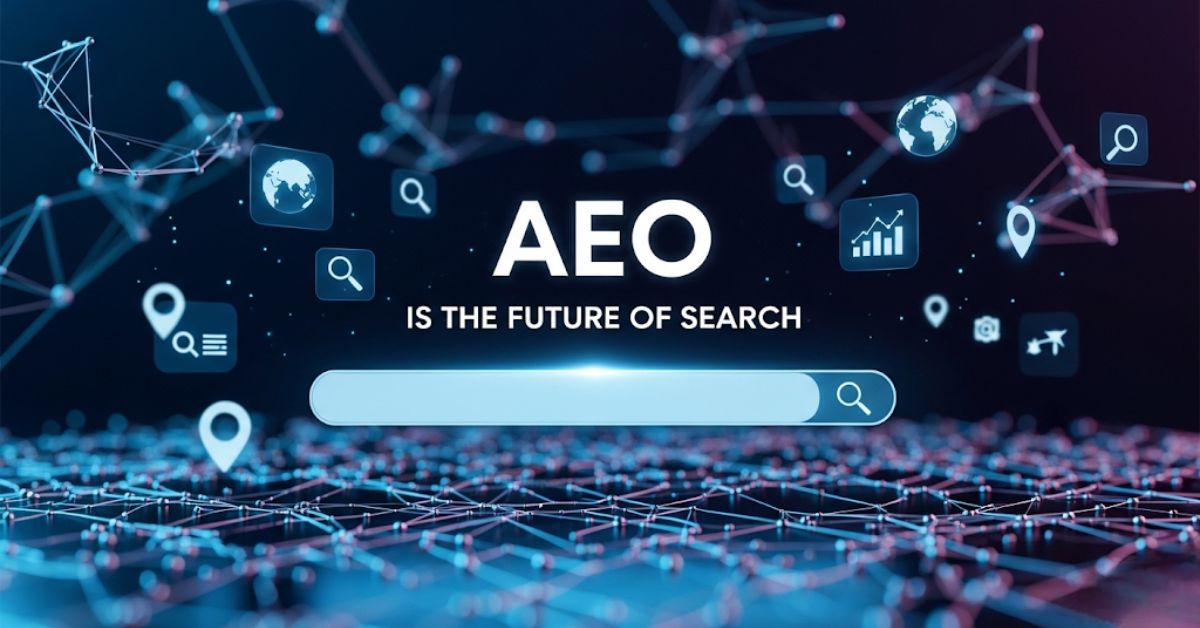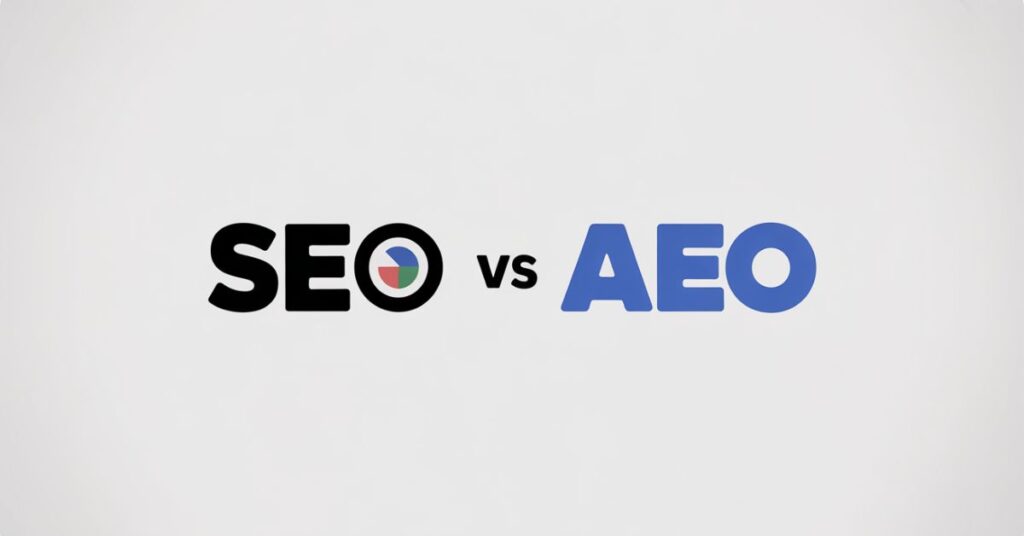The world of search is transforming at lightning speed. Traditional keyword-based SEO strategies are no longer enough to secure top rankings. As search engines like Google, Bing, and even AI tools like ChatGPT evolve to provide direct answers to user queries, the way we create and optimize content must evolve too. Enter AEO – Answer Engine Optimization. AEO is not just another buzzword. It’s a response to how users now consume information, quickly, directly, and with minimal effort.
In this article, we’ll dive deep into what AEO really is, how it differs from traditional SEO, and why it’s set to dominate the future of digital search. We’ll also break down the practical steps businesses and content creators can take to make their websites AEO-ready.
Why AEO Is the Future of Search
The future of search lies in how fast and accurate the answers are. With the rise of AI, voice search, and mobile-first experiences, people are no longer typing in vague queries and scrolling through ten links. They expect instant clarity.
Here’s why AEO is taking over:
1. Rise of Zero-Click Searches
Studies show that over 50% of Google searches now end without a click, meaning users find the information they need directly on the search results page. This shift is driven by Google’s focus on quick, direct answers. Answer Engine Optimization (AEO) helps your content appear in these prominent “zero-click” answer boxes, such as featured snippets and knowledge panels. Even if users don’t visit your site, AEO boosts your brand visibility, authority, and trust, right where users are searching.
2. Growth of Voice Assistants
By 2023, over 4.2 billion voice assistants like Siri, Alexa, and Google Assistant were in use, and that number continues to grow. Unlike traditional search, voice search doesn’t give users a list of options; it delivers a single answer. This shift demands content that’s optimized not just for ranking, but for direct answers. That’s where AEO (Answer Engine Optimization) comes in. AEO helps your content become the one trusted response these AI assistants choose to deliver instantly.
3. AI Is Replacing Traditional SERPs
AI tools like Google’s SGE, Bing AI, and ChatGPT are changing how people search by providing direct answers instead of just links. This shift means users get quick, summarized information without needing to visit multiple sites. Answer Engine Optimization (AEO) helps your content appear in these AI-generated answers. By structuring your content clearly and focusing on user intent, you increase the chances that AI tools will extract and feature your site’s information, giving you visibility in zero-click searches.
4. Better UX and Trust Signals
AEO (Answer Engine Optimization) promotes the creation of clear, structured, and informative content that directly addresses user questions. This approach enhances the overall user experience (UX) by making information easier to find and understand. When users can quickly get accurate, helpful answers, they are more likely to stay engaged with the page. Search engines recognize and reward such content by ranking it higher, as it aligns with their goal of delivering the best possible results to users.
How AEO Works (The Mechanics)
Understanding the technical and strategic elements of AEO is crucial to implementing it successfully.
Aligning Content with User Intent
You must know exactly what your audience wants and why they want it. Are they looking for a definition, a process, a product, or a comparison? AEO content is tightly matched to specific search intent.
Structuring Content for AI Interpretation
AI and search engines love structure. This means:
- Using question-based headings
- Short, direct paragraphs with clear answers
- Adding lists and tables when appropriate
- Including FAQs at the end of your articles
Using Structured Data and Schema Markup
Schema helps Google understand your content. You can use:
- FAQPage for frequently asked questions
- HowTo schema for instructional content
- Article schema for blog posts
Implementing structured data increases your chances of being featured in snippets or AI-generated summaries.
Building EEAT (Experience, Expertise, Authority, Trust)
AEO doesn’t ignore Google’s core ranking factors. You still need:
- Author bios with credentials
- External links to authoritative sources
- Internal linking to show topic depth
- Original insights or data, if possible
AEO vs SEO: Evolution, Not Replacement
AEO isn’t here to kill SEO, it’s here to refine and evolve it. Traditional SEO brought us here, but now we need to go one step further.
| Factor | SEO | AEO |
| Focus | Rankings & Traffic | Answers & Visibility |
| Keyword Use | Essential | Important, but user intent leads |
| Click Goals | CTR, links | Zero-click visibility |
| Optimization | Metadata, Backlinks | Structure, Schema, Direct Answers |
Smart marketers will blend both strategies: using SEO to drive long-tail traffic and AEO to capture answer boxes, voice queries, and AI snippets.
Real-World Examples of AEO in Action
Google Featured Snippets
When you search “What is AI?” on Google, the top result often appears as a direct, 2–3 sentence answer at the top, that’s Answer Engine Optimization (AEO) in action. These quick, clear definitions are pulled from well-structured content designed to match user intent. AEO helps your content become the featured snippet, increasing visibility, trust, and traffic. In fact, featured answers can receive over 8% more clicks than even the #1 organic result. It’s SEO, supercharged for AI-driven search engines.
Bing AI and ChatGPT Answers
Bing and AI tools like ChatGPT are increasingly pulling information directly from websites to answer user queries. If your content is clear, well-structured, and factually accurate, it has a higher chance of being cited or featured in AI-generated responses. This makes formatting and quality even more important. By optimizing for Answer Engine Optimization (AEO), your content becomes more discoverable and can serve as a trusted source for AI tools, driving visibility and authority for your site in a competitive digital landscape.
Voice Search Responses
Ever asked Alexa, Siri, or Google Assistant a question and heard just one clear answer in return? That single spoken response is often pulled from a top-ranking snippet or a site optimized for Answer Engine Optimization (AEO). Unlike traditional search results that show multiple links, AEO focuses on delivering direct, concise, and authoritative answers that voice assistants and AI systems trust. This shift in how search works highlights why AEO is becoming essential for future-ready content visibility.
Benefits of Adopting AEO Now
Long-Term Search Visibility
Search behavior is evolving at a rapid pace. Users are turning to voice assistants, AI chatbots, and zero-click searches for instant answers. Traditional keyword-based SEO alone can no longer guarantee visibility. This is where AEO (Answer Engine Optimization) shines. AEO prepares your content to be understood, selected, and presented directly by AI-powered engines like Google’s SGE, Bing Copilot, or ChatGPT. By structuring your content to align with user intent and provide clear, concise answers, AEO ensures your visibility in emerging search experiences, now and into the future.
Increased Brand Trust
When your content consistently appears as the authoritative answer to popular questions, it builds deep credibility with users. Whether it’s featured in a snippet, voice response, or AI-generated summary, being the “chosen answer” associates your brand with reliability and expertise. Over time, users begin to recognize your brand as a trusted source in your niche, even before clicking through.
Better Engagement and Retention
Answer-focused content is more direct, easier to digest, and offers faster value. Users stay longer, bounce less, and are more likely to share helpful, well-structured content. This improves on-site engagement and overall retention, a key ranking factor in modern search.
Competitive Advantage
Most websites still focus only on traditional SEO tactics. Brands that adopt AEO early gain a massive head start. By dominating AI answer spaces, they capture high-intent traffic long before competitors adjust. AEO isn’t just smart, it’s strategic.
Conclusion
SEO is evolving, and the natural next step is AEO. As users expect faster, more direct answers, and AI-driven search engines aim to meet that demand, your content must be structured to serve as the final, trusted answer. AEO ensures your content isn’t just ranked but selected and surfaced in answer boxes, voice responses, and AI-generated summaries.
Those who adopt AEO early gain a powerful edge. It’s no longer just about increasing clicks, it’s about becoming the go-to authority. Whether you’re a business owner, blogger, or digital strategist, adapting to AEO is your chance to boost visibility, earn user trust, and lead in a rapidly shifting search environment.



